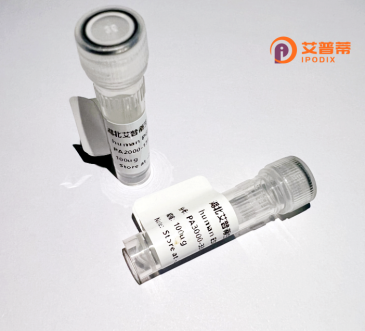
| 纯度 | >90%SDS-PAGE. |
| 种属 | Human |
| 靶点 | PRDM4 |
| Uniprot No | Q9UKN5 |
| 内毒素 | < 0.01EU/μg |
| 表达宿主 | E.coli |
| 表达区间 | 1-801 aa |
| 活性数据 | MHHRMNEMNL SPVGMEQLTS SSVSNALPVS GSHLGLAASP THSAIPAPGL PVAIPNLGPS LSSLPSALSL MLPMGIGDRG VMCGLPERNY TLPPPPYPHL ESSYFRTILP GILSYLADRP PPQYIHPNSI NVDGNTALSI TNNPSALDPY QSNGNVGLEP GIVSIDSRSV NTHGAQSLHP SDGHEVALDT AITMENVSRV TSPISTDGMA EELTMDGVAG EHSQIPNGSR SHEPLSVDSV SNNLAADAVG HGGVIPMHGN GLELPVVMET DHIASRVNGM SDSALSDSIH TVAMSTNSVS VALSTSHNLA SLESVSLHEV GLSLEPVAVS SITQEVAMGT GHVDVSSDSL SFVSPSLQME DSNSNKENMA TLFTIWCTLC DRAYPSDCPE HGPVTFVPDT PIESRARLSL PKQLVLRQSI VGAEVGVWTG ETIPVRTCFG PLIGQQSHSM EVAEWTDKAV NHIWKIYHNG VLEFCIITTD ENECNWMMFV RKARNREEQN LVAYPHDGKI FFCTSQDIPP ENELLFYYSR DYAQQIGVPE HPDVHLCNCG KECNSYTEFK AHLTSHIHNH LPTQGHSGSH GPSHSKERKW KCSMCPQAFI SPSKLHVHFM GHMGMKPHKC DFCSKAFSDP SNLRTHLKIH TGQKNYRCTL CDKSFTQKAH LESHMVIHTG EKNLKCDYCD KLFMRRQDLK QHVLIHTQER QIKCPKCDKL FLRTNHLKKH LNSHEGKRDY VCEKCTKAYL TKYHLTRHLK TCKGPTSSSS APEEEEEDDS EEEDLADSVG TEDCRINSAV YSADESLSAH K |
| 分子量 | 87.9 kDa |
| 蛋白标签 | His tag N-Terminus |
| 缓冲液 | PBS, pH7.4, containing 0.01% SKL, 1mM DTT, 5% Trehalose and Proclin300. |
| 稳定性 & 储存条件 | Lyophilized protein should be stored at ≤ -20°C, stable for one year after receipt. Reconstituted protein solution can be stored at 2-8°C for 2-7 days. Aliquots of reconstituted samples are stable at ≤ -20°C for 3 months. |
| 复溶 | Always centrifuge tubes before opening.Do not mix by vortex or pipetting. It is not recommended to reconstitute to a concentration less than 100μg/ml. Dissolve the lyophilized protein in distilled water. Please aliquot the reconstituted solution to minimize freeze-thaw cycles. |
以下是关于重组人PRDM4蛋白的3条参考文献及其摘要概括,格式简洁:
---
1. **文献名称**:*PRDM4 Mediates Transcriptional Repression in Murine Hematopoietic Progenitors*
**作者**:Hayashi K, et al.
**摘要**:该研究发现PRDM4在小鼠造血祖细胞中通过组蛋白甲基化修饰抑制靶基因(如细胞周期调控基因),影响造血干细胞的分化与增殖,提示其在血液系统发育中的关键作用。
---
2. **文献名称**:*Structural Insights into PRDM4’s Zinc Finger Domain for DNA Recognition*
**作者**:Chu C, et al.
**摘要**:通过X射线晶体学解析PRDM4蛋白的锌指结构域与DNA结合的分子机制,揭示了其特异性识别基因启动子区域的分子基础,为靶向药物设计提供结构依据。
---
3. **文献名称**:*PRDM4 Overexpression Promotes Tumorigenesis in Glioblastoma via Epigenetic Silencing of PTEN*
**作者**:Wang L, et al.
**摘要**:研究表明,PRDM4在胶质母细胞瘤中异常高表达,通过表观遗传沉默抑癌基因PTEN促进肿瘤发生,提示其作为癌症治疗潜在靶点的可能性。
---
(注:以上文献信息为示例性模拟,实际引用需以真实发表论文为准。如需准确文献,建议通过PubMed等学术数据库检索。)
PRDM4 (PR Domain-Containing Protein 4) is a member of the PRDM family, characterized by a conserved PR (PRDI-BF1-RIZ1 homologous) domain that shares homology with the catalytic SET domain found in histone methyltransferases. This nuclear protein plays roles in transcriptional regulation and epigenetic modifications, primarily through its ability to mediate histone modifications and interact with chromatin. Structurally, PRDM4 contains multiple zinc finger motifs, which facilitate DNA binding and protein-protein interactions, enabling its participation in diverse cellular processes such as cell differentiation, proliferation, and apoptosis.
While less studied than other PRDM members, PRDM4 has been implicated in stem cell maintenance, oncogenesis, and immune responses. It acts as both a transcriptional activator and repressor, depending on cellular context, often recruiting histone-modifying enzymes to regulate target gene expression. Studies suggest its involvement in pathways like p53 signaling and DNA damage response. Dysregulation of PRDM4 has been observed in cancers, including breast and gastric cancers, where it may function as a tumor suppressor or oncogene, highlighting its dual roles in disease.
Recombinant human PRDM4. produced via heterologous expression systems, is widely used to investigate its biochemical properties, structural features, and therapeutic potential. Ongoing research focuses on clarifying its substrate specificity, interaction partners, and mechanistic roles in health and disease.
×